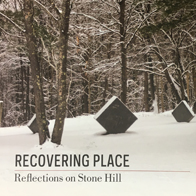Heather Williams became enthralled with the natural world as a child, when her family lived in Turkey, Bolivia, and Laos. Her research focuses on bird song: how and when it is acquired, the brain mechanisms responsible for imitative learning, how syllable arrangements vary with context, and the way songs evolve over time. She has been teaching at Williams College since 1988.

July 4–October 10, 2016
sparrow songs and boundaries
Sparrow songs and boundaries
Audio recordings and sonograms
Stone Hill, May 2015
TRANSCRIPT:
Song sparrows are well named: they are small and easy to ignore until they open their bills and let fly with distinctive vocal virtuosity. In a sonogram (which shows time along the horizontal axis and pitch on the vertical axis), the complex sequence of song sparrow notes forms a particularly beautiful calligraphy: we can see features that are hard to distinguish by ear, such as note complexes, whistles, buzzes, trills, and wide swoops in pitch.
The songs and sonograms you find here are from a male with a territory in the Clark’s south pasture, an open area traversed by the Pasture Trail. One boundary, the tree line, is as apparent to humans as it is to the birds. The other boundaries are more arbitrary but are equally clear to the sparrow and his neighbors. They have partitioned the field into areas as large as each one can claim with the tools at his disposal: songs and physical aggression.
In the recordings you hear, the male sings five distinct song types. He shares some of them with his neighbors and uses the shared song types to escalate confrontations—matching what his neighbor sings when stakes are high and he is willing to fight. Many neighbors are familiar; surviving males return to the same territory each spring, where they recognize each other and their songs and acknowledge the same unseen boundaries from the previous year. Females arrive later, listen to the quality and variety in the males’ songs, and eavesdrop on their interactions.
Each female also assesses the resources available within the landscape (food, good nesting sites, shelter), and then joins the available male that she judges to have the best combination of personal characteristics and territory. In this way, a male’s song repertoire defines the physical and social boundaries of his life.
Recovering Place: Reflecting on Stone Hill
By Mark C. Taylor
An illustrated book chronicling the land art and sculptures created by Mark C. Taylor at his home in the Berkshire hills, echoing themes found in the exhibition. Supported in part by Herbert A. Allen, Jr. and the Clark Art Institute and published by Columbia University Press. Call the Museum Store at 413 458 0520 to order.


